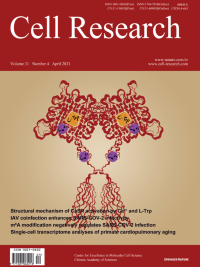
Advanced Search
Submit Manuscript
Advanced Search
Submit Manuscript
Volume 31, No 4, Apr 2021
ISSN: 1001-0602
EISSN: 1748-7838 2018
impact factor 17.848*
(Clarivate Analytics, 2019)
Volume 31 Issue 4, April 2021: 463-477 |
Dissecting the epigenomic dynamics of human fetal germ cell development at single-cell resolution
Li Li2,7,8 , Lin Li3 , Qingqing Li1,2 , Xixi Liu1 , Xinyi Ma1 , Jun Yong1 , Shuai Gao1 , Xinglong Wu1 , Yuan Wei1,4 , Xiaoye Wang1,4 , Wei Wang1,4 , Rong Li1,4 , Jie Yan1,4 , Xiaohui Zhu1,4 , Lu Wen1,2 , Jie Qiao1,4,5,6 , Liying Yan1,4,5,* , Fuchou Tang1,2,6,*
1Beijing Advanced Innovation Center for Genomics, Department of Obstetrics and Gynecology, Third Hospital, School of Life Sciences, Peking University, Beijing 100871, ChinaProper development of fetal germ cells (FGCs) is vital for the precise transmission of genetic and epigenetic information through generations. The transcriptional landscapes of human FGC development have been revealed; however, the epigenetic reprogramming process of FGCs remains elusive. Here, we profiled the genome-wide DNA methylation and chromatin accessibility of human FGCs at different phases as well as gonadal niche cells at single-cell resolution. First, we found that DNA methylation levels of FGCs changed in a temporal manner, whereas FGCs at different phases in the same embryo exhibited comparable DNA methylation levels and patterns. Second, we revealed the phase-specific chromatin accessibility signatures at the promoter regions of a large set of critical transcription factors and signaling pathway genes. We also identified potential distal regulatory elements including enhancers in FGCs. Third, compared with other hominid-specific retrotransposons, SVA_D might have a broad spectrum of binding capacity for transcription factors, including SOX15 and SOX17. Finally, using an in vitro culture system of human FGCs, we showed that the BMP signaling pathway promoted the cell proliferation of FGCs, and regulated the WNT signaling pathway by orchestrating the chromatin accessibility of its ligand genes. Our single-cell epigenomic atlas and functional assays provide valuable insights for understanding the strongly heterogeneous, unsynchronized, yet highly robust nature of human germ cell development.
https://doi.org/10.1038/s41422-020-00401-9